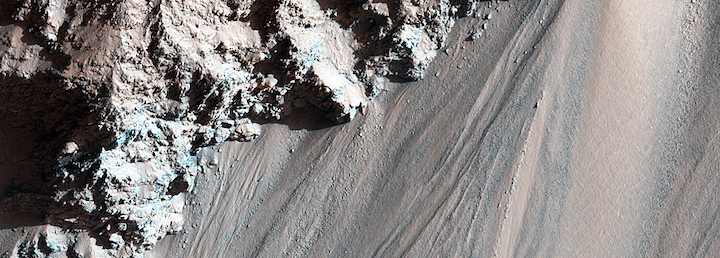7.09.2019

Mass Wasting and Slope Processes
“Mass wasting“ is a broad science theme dealing with the downhill movement of rocks and debris. Many different types of mass movement fall into the general category of mass wasting, from large landslides and debris avalanches to rockfalls, debris flows and soil creep. On Mars, mass wasting landforms are seen at a range of scales, from giant rock avalanches to tiny slumps and single rockfalls.
Current Slope Processes
One of the most exciting discoveries of recent spacecraft exploration is the assortment of changes that we can see occurring on Martian slopes today.
- Dark flows termed “Recurring slope lineae” (or RSL) are seen slowly advancing down warm slopes in the summer.
- New mass movements are seen in Martian gully landforms, and generally occur in the late winter or spring, potentially triggered by the carbon dioxide frost that coats the surface in the winter.
- Avalanches are seen in action on steep slopes at the edge of the North Polar Layered Depositswhen they are warming in Northern spring.
- Slope streaks are seen in dusty regions of Mars and are thought to be the result of dust avalanches, sometimes triggered by impact craters or rockfalls.
- New rockfalls and boulder tracks are also seen on steep slopes.
A major goal of this theme is to find and describe current mass wasting changes.
Major Science Questions
The discovery of many different types of active slope processes raises many questions. Where and how often do different types of changes occur? How much variation is there from place to place, and from year to year? What causes each type of activity? Have other types of mass movement occurred in the past? How much do these changes affect the surface topography? Some types of activity that we see today might be due to water, while others are not. Learning how current processes shape the landscape can help us understand the history of water on Mars.
To answer these questions, HiRISE takes images of steep slopes like crater walls to look for signs of activity, and looks back at places where we have older images to look for changes. Since HiRISE cannot look everywhere all the time, some of these places are imaged often to study in detail, while many others are imaged occasionally to get a broader sample of surface changes. Other images in the theme are targeted to look at older rock avalanches and other mass wasting features to learn about the whole scope of slope processes on Mars.
Quelle: HIRISE, NASA
